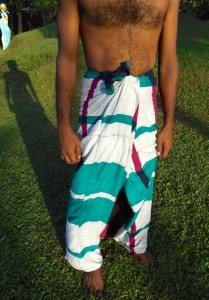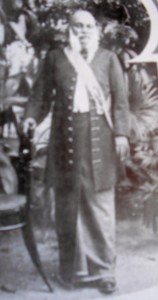SRI LANKA ROUNDABOUT (Number 14) – SARONG STYLE
by · Published · Updated
A weekly look at Sri Lanka for Jetwing by Royston Ellis
Welcome to Jetwingers around the world to this week’s issue of my regular Jetwing newsletter about Sri Lanka.

Modern day sarong
I was fascinated when I first settled in Sri Lanka to see pairs of men walking along the street holding hands and wearing what seemed to be an ankle length skirt. I quickly realised that hand-holding among men (which seems to have died out) signified nothing more than a bond of friendship. While the ‘skirt’ was the normal wear for men in Sri Lanka and is known as a ‘sarong.’
When the sarong worn with such flair by men in Sri Lanka first became fashionable is unknown. The book Costumes of Sri Lanka suggests it became popular in British colonial times when ‘men wore the lower sarong two and a half metres in length sewn together at its ends.’
The narrative adds: ‘the comfort of the sarong, loosely draped over the lower body and the ubiquitous banyan for the upper body were, and still remain, the favoured clothing for home wear among men. The sarong is also the outdoor garment of the working class, be it Sinhalese, Tamils or Muslims.’
The Oxford English Dictionary defines sarong as ‘a sort of skirt’ and records the first usage of the word in print in 1834 as a description of a Malay man ‘attired in a dirty sarong around his waist.’ It is thought the Malay word sarung was derived from the Sanskrit saranga.

Sarong as worn 105 years ago.
The sarong of Sri Lanka has many cousins throughout Asia and there is an equivalent cloth for women of the island, a wraparound skirt called redda. While the wearing of a sarong in public is not as common as it was 35 years ago, having been replaced by trousers for the city slicker and calf-length shorts for the trendsetting tuk-tuk driver, even the most status-conscious Sri Lankan man will happily don a sarong when he is at home.
And why not? The sarong is such a practical garment. It can be hitched up to knee length when doing chores, used as a body covering while sleeping, and even as a shielding sheath when changing clothes in a crowded room.
It took me weeks of practice to learn how to tie a sarong properly instead of knotting it as I would when wearing a towel. I learned there is a ritual that involves pulling the sarong over one’s head and extending it out full width in front before tightly folding one side over the other and tucking the ends in so the sarong is held securely in place by the pressure of stomach against the fabric.
Sarongs are now available in dashingly colourful hand woven fabrics, bright batik patterned cloth, or cool printed cotton. A sarong makes a great gift for a man, even if only used as night wear.
Royston Ellis (www.roystonellis.com) is a British author resident in Sri Lanka since 1980.




